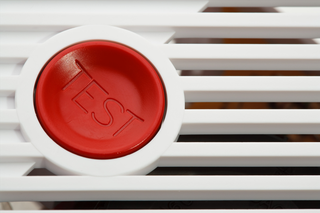If you do not have a working smoke alarm, consider fitting one today.
A working smoke alarm buys you time by alerting you to the presence of smoke. This gives you a chance to escape from injury and potentially death.
If your home catches fire, the smell of smoke will not wake you up. Inhaling smoke and other toxic gases can put you in a deeper sleep. Brain death happens when the brain is deprived of oxygen for as little as 3 minutes.
Where to install smoke alarms
Get at least one smoke alarm for each floor in your home. For example, the ground floor and first floor if you live in a two-storey house. Put one in your hallway and one at each upper level in the landing area.
Fit them between the sleeping areas and the kitchen and living rooms.
A smoke alarm on each floor in your home is a minimum. Aim to have one in every room so that fire will be discovered as early as possible.
Install a smoke alarm in the:
- living room
- kitchen
- bedrooms used by children or vulnerable people
- bedrooms used by smokers
- bedrooms with a television or other electrical appliances like a computer
- garage
Smoke alarms with a 10-year life span are best. These come with a lithium battery that will not need to be changed during the life span of the alarm.
Older smoke alarms run on batteries that you have to replace every year.
Heat detectors
Heat detectors are also known as heat alarms. They can be used in places where a smoke alarm might go off unnecessarily.
These areas include:
- kitchen areas where there are fumes from cooking
- areas where there could be smoke from cigarettes
- rooms where there is an open fire
Put heat detectors at ceiling level. Follow the manufacturer’s instructions.
Alarms you can install if you have a hearing difficulty
If you are deaf or have impaired hearing, you may not hear the sound of a smoke alarm. The alarm could also go off at night when the person is not wearing a hearing aid.
You can get smoke alarms that use strobe lights or vibrating pads. These alert people with hearing difficulties to danger from fire.
Testing your smoke alarm
It is recommended that you test smoke alarms once a week. This is to check that they are working correctly. You can test them by pressing the test button. If you cannot reach the test button, use the handle tip of a sweeping brush to press it.

Replacing batteries
If your smoke alarm runs on batteries, you should replace these with new ones:
- when the old ones are not working
- as soon as you hear the warning beep
- once a year in standard alarms
Replace batteries immediately if they are not working. Do not put it off.
Keeping the alarm clean
Vacuum the smoke alarms regularly and wipe the cover. If they get clogged with dust they may not work properly.
Replacing your alarm
There is an expiry date on smoke alarms. Replace the whole alarm when it reaches this expiry date. If you have a 10-year smoke alarm, you need to replace it after 10 years.
Carbon monoxide alarms
You also need to have carbon monoxide alarms in your home.
Carbon monoxide poisoning can happen with gas, oil, coal or other fuels. You cannot see or smell carbon monoxide.